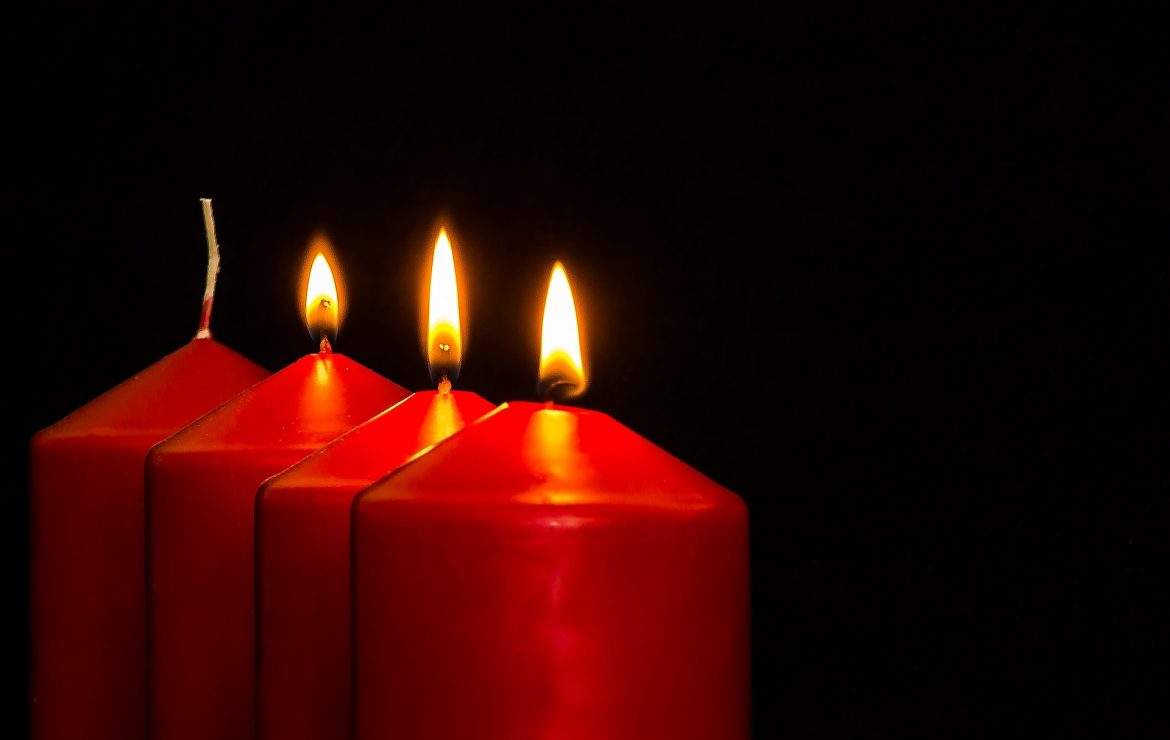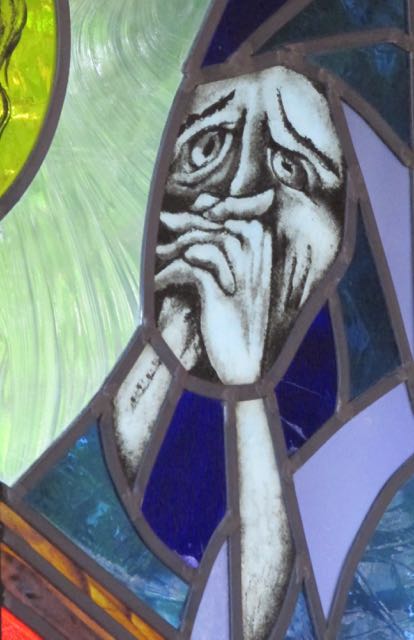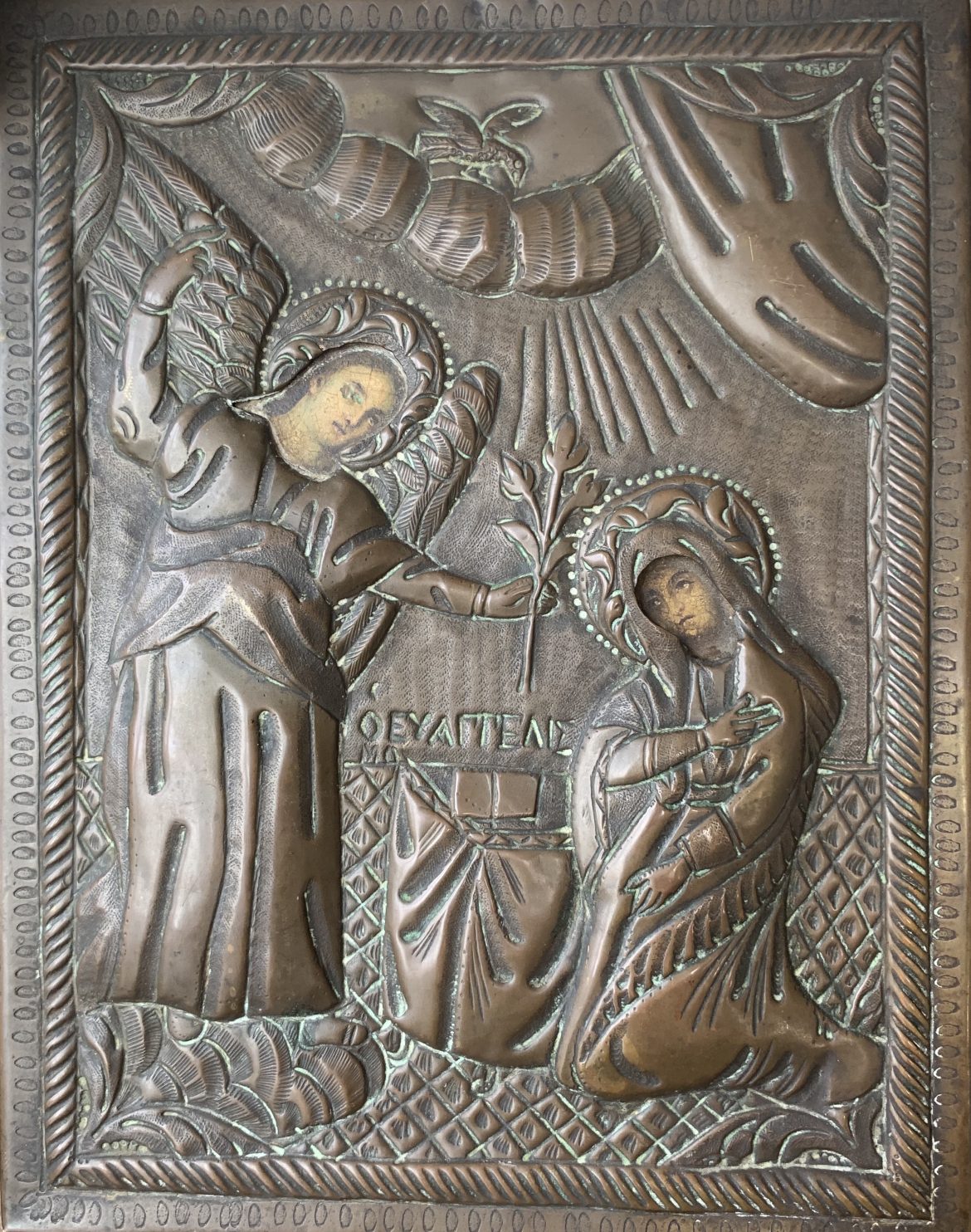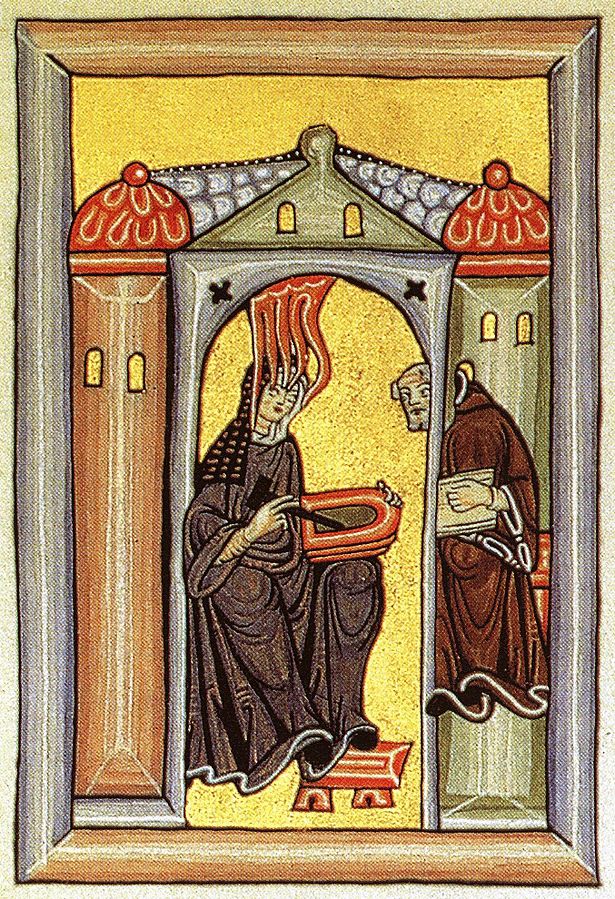Darkness has been a regular companion for me in the cycles of deepening relationship with God. Usually, suffering of some sort accompanies the lightless season. I’ve had enough experiences like this now that I’ve learned not to panic. The first time around I was terrified. I thought something was wrong with me. I thought I must be losing my way. I thought either there is no God or God is so out of reach that I’ll never realize God’s real presence.
Sure, in my younger life I had had plenty of spiritual experiences. Some I’m sure were authentic. Most were fairly emotional, perhaps some even emotionally manipulated. At any rate, early in the spiritual journey I enjoyed a number of experiences that reinforced God’s love for me. But then, the practices that used to help stir up a spiritual experience—worship music, spiritual teaching from the church, Bible reading, and prayer—ran dry. They didn’t support my connection with God like they used to. I found myself alone, in obscurity.
Thankfully, the right teachers came into my life and introduced me to contemplative practice as a way of sustaining my faith journey. It’s like I was given practices not so much to light the way through the shadows but instead to teach me how to walk in the dark.
During winter seasons in the journey, our spiritual senses are concealed so that our vision for reality can be refined. “Now we see indistinctly, as in a mirror; then we will see face to face. My knowledge is imperfect now; then I will know even as I am known” (1 Corinthians 13:12). In a way, it’s like eye surgery. We have to suffer momentary blindness to receive precision of sight.
Years ago, my friends Jeelan and Nazreen gave me the gift of physical sight. Jeelan was born into an Urdu-speaking folk Muslim family in the heart of South India’s Tamil Nadu. Nazreen was born into a progressive Pakistani-Malay Muslim family. She grew up in Singapore. When Jeelan moved to Singapore for work, they met, fell in love and eventually married. Today, they are raising their two beautiful children near San Francisco. In all my travels around the world, no one has been more family to me than Naz and Jeel.
I had been nearsighted from the time I was nine years old. I remember as a young student in second or third grade trying to read the classroom chalkboard and using my index fingers to squint my eyes to help make out the teacher’s writing. My eyesight used to be so bad that I couldn’t see the bedside clock in the morning. As you can imagine, frequent travel to various places around the world made dealing with contact lenses and glasses rather difficult. By the time I was an adult, Lasik corrective eye surgery had come a long way, and I wondered if I would ever be able to afford it. It would be a miracle to have my eyesight restored without the need of corrective lenses.
My friends Nazreen and Jeelan got wind of my desire for the surgery and to my surprise offered to pay for it so I wouldn’t have to wait any longer. Imagine. A Muslim gave me, a Christian, sight.
The surgery and recovery were quite an experience. Before the operation, the nurse gave me something to help me relax. Then she secured my eyelids open. The next thing I knew, a laser beam was penetrating my eye. All grew dark. I don’t remember a lot after that. When it was time to leave the clinic, patches were put over my eyes. When I returned home, in the dark, unable to see, I could do nothing but sleep. When I woke, it was safe to remove the bandages. I remember the anticipation. Would I really be able to see without my glasses? And sure enough, I could easily read the bedside clock.
Clear sight wasn’t exactly instantaneous. It took a little while for my eyes to adjust. I even had to go back to the surgeon for a minor surgical adjustment. It’s like this in a spiritual sense too. At times, we have to enter periods of darkness so that God can perform miracles in perception. It’s scary. And it requires every ounce of trust we’ve got. But when the darkness lifts, we see in a new way. There may be an adjustment period, but soon enough we stabilize with new spiritual sight. And in all likelihood, there will be times when we have to enter the darkness again for an adjustment.
In some ways, the role of darkness in the spiritual journey is like the story of Moses who wanted to encounter the living God. God said that no one has seen the face of God and lived, so Moses had to take cover in a cave (retreat into darkness) while the presence of God passed by (Exodus 33:12‑23).
It’s true that we cannot see the face of God and live (Exodus 33:20). At least the false self cannot live in the presence of God. As we draw nearer to God, we take cover in the dark while the false self is burned away. If we want to “see” (become aware) of the reality of God, the false self has to die, or let go of its dominance. For ultimately, as Father Richard rightly points out, everything belongs. It’s just a matter of the false self-dying to its prominence or dominance in one’s life. This is the work of the spiritual journey. This is what it means to do your inner work. The false ideas, misperceptions, and skewed beliefs about God and, quite frankly, about ourselves have to metaphorically burn up in divine light.
*Taken from Mindful Silence by Phileen Heuertz. Copyright (c) 2018 by Phileena Heuertz. Published by InterVarsity Press, Downers Grove, IL. www.ivpress.com
 Phileena Heuertz is the author of Pilgrimage of a Soul and Mindful Silence and a founding partner of Gravity, a Center for Contemplative Activism. For nearly twenty years she and her husband, Chris, codirected an international nonprofit in more than seventy countries, building community among victims of human trafficking, survivors of HIV and AIDS, abandoned children, and child soldiers and war brides.
Phileena Heuertz is the author of Pilgrimage of a Soul and Mindful Silence and a founding partner of Gravity, a Center for Contemplative Activism. For nearly twenty years she and her husband, Chris, codirected an international nonprofit in more than seventy countries, building community among victims of human trafficking, survivors of HIV and AIDS, abandoned children, and child soldiers and war brides.
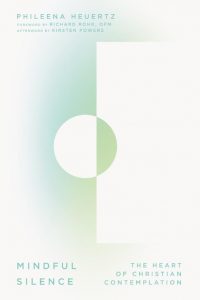
As an Amazon Affiliate Godspace receives a small amount for purchases made through Amazon links.
by Christine Sine
Today’s litany for the Third week of Advent is from my book Waiting for the Light.
The coming of our Lord is near,
Something new is around the corner,
Love, joy, peace and hope,
We await the promise of your coming.
The coming of our Lord is near,
Something new is appearing,
A child, a saviour, God’s much beloved son,
We await the hope of your coming.
The coming of our Lord is near,
Something new is being birthed,
A new heaven, a new world, a new community,
We await the long expected One.
The coming of our Lord is near,
We wait in joyful expectation for what is emerging,
Love comes down at Christmas,
And we await your coming.
(Pause to light the appropriate Advent candles)
The coming of our Lord is near
and we await the promise of your coming,
Light of the world draw close,
Shine on us with your guiding presence,
Shine in us with your truth and forgiveness,
Shine through us with your mercy and love.
The coming of our Lord is near
and we await the promise of your coming,
Bring light and life and love into our world,
Lead us to the fullness of life,
Where peace and righteousness kiss,
Where truth and justice embrace.
Come Lord Jesus come
You who are love incarnate,
You who give life eternal,
You who are the One in whom all things find completion,
Draw close and teach us the ways of peace.
Come Lord Jesus come,
You who are fully human yet fully God,
Come again into our world,
Come again into our lives,
Draw close, come again and make us whole.
Scripture Readings: read appropriate scriptures for the day.
Our Father who art in heaven hallowed be thy name. Thy kingdom come, thy will be done, on earth as it is in heaven. Give us this day our daily bread and forgive us our trespasses as we forgive those who trespass against us. Lead us not into temptation but deliver us from evil, for thine is the kingdom the power and the glory, forever and ever. Amen.
God who is justice, come.
Come to refugees and victims of violence throughout the world.
God who is righteousness, come.
Come to all who have been mistreated and abused.
God who is compassion, come.
Come to all who are sick and in need of healing.
God who is love, come.
Come to all who hate and live in fear.
Light of the world come, draw near,
In this Advent season come into our world afresh,
Draw all the world’s people into your embrace,
Open our hearts to welcome you.
Light of the world come, draw near,
Shine your star that we might follow,
Let angel choruses welcome you,
And proclaim your peace through all the earth.
Light of the world come, draw near,
Birth in us something new,
Fill the emptiness within,
Let your love overflow in us, through us, beyond us.
Amen.
Week 3 of Advent from John Lewis’ book, Finding the Treasure in Christmas: A Guide to celebrating Advent for Families —
Special Activities:
- Take the baby Jesus from the Nativity set, wrap Him in a box, and put Him under the tree as the first gift. Remember, the starting place of Christmas is receiving the gift of Jesus.
- Wrap and put some presents under the tree.
- Put up your stockings, remembering the legend of Santa Claus (see Reflect below) and that traditionally gifts were put in socks hung to dry over the fireplace.
- Read a suggested story from the New Guideposts Christmas Treasury, found in Appendix II.
- Watch: It’s a Wonderful Life(Theme: Our life is a gift to the world); The Toy that Saved Christmas/Veggie Tales(Theme: Christmas is not about getting gifts, but about giving, just as God gave Jesus); The Drummer Boy(Theme: We need to give the gift of ourselves to baby Jesus).
Read:
Read Isaiah 9:6; Luke 2: 8-12, 15-18 as you light the third Advent candle, which is the “Shepherd’s Candle.”
Reflect:
Santa Claus comes from the legend of Saint Nicholas, a bishop who lived centuries ago and who deeply loved God and people. He became famous for showing his gratitude to God by giving gifts to the poor in his city, and especially for the children. Legend has it he left his gifts in the stockings they had laid by the hearth or by their bed to dry overnight. His story has since captured the hearts of the world. Nearly every nation has some kind of tradition of giving surprises and goodies to children on Christmas. This tradition of giving and receiving presents, and of leaving out stockings to be filled on Christmas Eve, can all be traced back to Saint Nicholas. He freely received from Christ, so freely he gave (Matt. 10:18).
This same response of giving is wonderfully displayed in the first Christmas shepherds. In an obscure field, angels sang to these bedraggled and forgotten folk. Motivated by the mysterious gift of the Christ child, the shepherds eagerly spread the story of the angels’ message, first to Mary and Joseph, and then to whomever would listen. Proclaiming God’s gift to them became their gift to those around them.
However, it is easy to forget that the foundation of our holiday giving is the extravagant coming of Christ. As Jesus’ followers, we can be tempted by store sales, helping prop up the economy, or merely following a cultural custom. Shouldn’t we be motivated to give by something deeper? “We love because God first loved us,” and God never loved us more than when He sent His only Son (John 3:16).
The meaning of Jesus’ name –“God saves”– reminds us that it is in Jesus’ very nature to give out of His abundance. Christ’s two-step cadence of receiving and giving is equally woven into our nature. As those called by Love and those who have freely received God’s “grace upon grace” (John 1:16); we are also called to give. Grace piled upon grace.
Our Christmas giving sets the course for how we should live all year long. Inspired by the eagerness of the shepherds, we should end the holidays ready to share thrilling story of Jesus.
Sing:
“Silent Night” (especially verse 2)
Pray:
God, You gave the greatest treasure in sending Jesus, Your Son. He came wrapped in such a way that most of the world did not know, and still doesn’t know, that He is our long awaited King. Open our eyes to see the gift of the baby Savior, and through Him the gift of life. Let our to each other this Christmas be our way of saying thank You for Your wonderful love, expressed most extravagantly in Your Son, Jesus Christ. Amen.
 John Lewis lives in Tacoma, Washington and is a father of three grown children and husband of one Christmas-loving wife. He is the director of Kingdom Story Ministries and passionate about seeing the next generation of Jesus followers grow and stay faithful over their life time. Building meaningful and enduring traditions during the Advent season, the month before Christmas, was certainly one way their kids found long term faith roots. Those 15 years of trial and error, singing carols and squirming in their seats, reading and sharing, putting up the tree, lights, ornaments and star one week at a time, they were well worth the effort. Though far from perfect, we offer to you our flexible approach and variety of ideas for developing Christ centered Christmas traditions. May your kids, year after year, grow anticipate the faith element of Christmas alongside all the fun of the season; may their roots run long and deep for the challenging life they have ahead of them.
John Lewis lives in Tacoma, Washington and is a father of three grown children and husband of one Christmas-loving wife. He is the director of Kingdom Story Ministries and passionate about seeing the next generation of Jesus followers grow and stay faithful over their life time. Building meaningful and enduring traditions during the Advent season, the month before Christmas, was certainly one way their kids found long term faith roots. Those 15 years of trial and error, singing carols and squirming in their seats, reading and sharing, putting up the tree, lights, ornaments and star one week at a time, they were well worth the effort. Though far from perfect, we offer to you our flexible approach and variety of ideas for developing Christ centered Christmas traditions. May your kids, year after year, grow anticipate the faith element of Christmas alongside all the fun of the season; may their roots run long and deep for the challenging life they have ahead of them.
There is much on all our minds as we prepare for Christmas this year that is not pleasant. The fires in California that have killed so many and left many more homeless. The tragic plight of almost 90 million displaced people around the world, war in Ukraine and many other places, fears about climate change and its potentially devastating impact on our planet, and our own personal tragedies of lost loved ones, friends or relatives with terminal illnesses, and other losses mean that our hearts are grieving. In 2023, we are certainly experiencing situations and difficulties like never before. So why do we try to cover our pain and grief with Yuletide cheer?
Many churches recognize that Festivals of Carols, celebrations of Christmas, and children’s pageants do not meet everyone’s needs. To fill this gap churches offer a Blue Christmas service, a Service of Solace or Longest Night. People who are not having a very merry Christmas and friends who support them are invited to come and sit with one another in a liturgy that speaks of the love of God for the grieving.
Godspace writers have posted several times in the past about this but thought that this year I would combine some of the resources into a single post so that those of you who are planning services or your own personal ritual can easily access them. Some are creative ideas for activities that facilitate grieving.
One post I do want to highlight from the past however is Katie Kennington Steer’s beautiful poem/post as part of her personal grieving as well as her post for Blue. Christmas 2020 – Feeling Blue
The Empty Chair
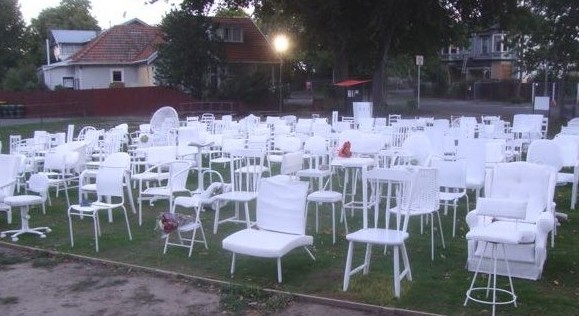 An empty chair is a powerful symbol of loss and can really facilitate our grieving. Creating a prayer station composed only of empty chairs or having empty chairs at the front of the sanctuary are both simple but powerful worship tools. If you have a small group of participants you might like to suggest each person grabs one of the empty chairs and sits it next to them at one point in the service. The image above is from a memorial service Peter Majendie constructed following the Christchurch earthquake of 2011 – heart rending and effective.
An empty chair is a powerful symbol of loss and can really facilitate our grieving. Creating a prayer station composed only of empty chairs or having empty chairs at the front of the sanctuary are both simple but powerful worship tools. If you have a small group of participants you might like to suggest each person grabs one of the empty chairs and sits it next to them at one point in the service. The image above is from a memorial service Peter Majendie constructed following the Christchurch earthquake of 2011 – heart rending and effective.
Use Lots of Candles
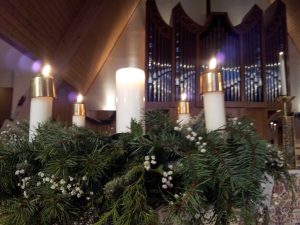
Four candles are often lit in Blue Christmas ceremonies: 1) One candle is lit for those who have passed, giving thanks to the memory that connects them to us this season; 2) One candle is lit to redeem the pain of the loss; 3) One candle is lit to honor ourselves; and, 4) One candle is lit for the gift of faith and hope symbolized in the Christmas story. However the lighting of candles by each of the congregation and the creating of a prayer table for all those we have lost can provide an even more compelling statement.
Create a Collage

Ask people attending the service to bring photos of those people or situations for which they are grieving. At one of the tables have a large sheet of cardboard on which people can paste their photos to create a collage.
Remember
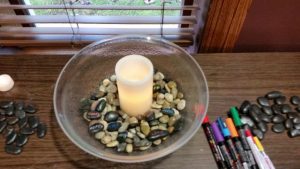 Provide ribbon or paper for people to write names or prayers on. Our church does this for All Saints Day and the ribbon then hangs in the sanctuary until Advent begins. If you have an artist in your congregation who can create a collage from these ribbons and prayers. In the photo above we used small rocks instead, writing peoples’ names on them and then putting them in the bowl around the candle. At the end of the service people took out their stones to take home.
Provide ribbon or paper for people to write names or prayers on. Our church does this for All Saints Day and the ribbon then hangs in the sanctuary until Advent begins. If you have an artist in your congregation who can create a collage from these ribbons and prayers. In the photo above we used small rocks instead, writing peoples’ names on them and then putting them in the bowl around the candle. At the end of the service people took out their stones to take home.
Symbols of Pain and Suffering
 Our good friend Mark Pierson is one of the most creative worship curators I know. I still remember him using zip ties and barbed wire crosses in a worship service that had all of us grieving for the abandoned and despised in our world.
Our good friend Mark Pierson is one of the most creative worship curators I know. I still remember him using zip ties and barbed wire crosses in a worship service that had all of us grieving for the abandoned and despised in our world.
Zip or cable ties, are used as handcuffs in many parts of the world and can effectively be used as symbols of bondage either in our own lives or in the lives of the suffering people around the world that we identify with.
One possibility is to give each person a zip tie at the beginning of the service. After a period of quiet prayer and reflection encourage them to come to the front where a chain link fence or screen has been set up. Participants attach their cable tie to the fence as a symbol of identification of the suffering of people unjustly treated, or senselessly killed around the world. They then pick up a barbed wire cut off cross to take back to their seat as a reminder that Jesus accepted us and came to earth to relieve our suffering and pain. The barbed wire is also a symbol of our willingness to accept responsibility of the suffering of others and to do what we can to alleviate it.
Symbols of Hope
 Most people do not want to leave a service with a feeling of despair or hopelessness. Providing a table at which they can create a memorial for the season that gives them hope is one way to turn hopelessness into hope. You might like to provide paper and pencils for people to draw or doodle with, rocks for them to paint or plants to create gardens. Alternatively ask them to bring journals and photos to the event. Provide a table at which they can create artistic images of their loved ones or of the situations they are grieving.
Most people do not want to leave a service with a feeling of despair or hopelessness. Providing a table at which they can create a memorial for the season that gives them hope is one way to turn hopelessness into hope. You might like to provide paper and pencils for people to draw or doodle with, rocks for them to paint or plants to create gardens. Alternatively ask them to bring journals and photos to the event. Provide a table at which they can create artistic images of their loved ones or of the situations they are grieving.
Art journalling like this is becoming more and more popular. Creating pages with the images of those we love who have passed away, decorating them and using them as a focus for prayer during the season can be very healing. Personally, I am discovering more each year how healing a memorial garden or stone can be too and offering this creative exercise to others is something that I increasingly do at retreats and other events.
Resources for Blue Christmas
Services
- Fidelia Magazine has an excellent liturgy for a Blue Christmas service – When Christmas Hurts.
- re:Worship always has great resources and I think has the best list for Blue Christmas ideas of any site I have visited.
Music
- Lectionary Songs has some excellent suggestions on songs for such a service.
- And another good list of Songs of Lament to consider.
- Our church’s Longest Night service used the words of Mumford and Sons song “After the Storm” for the prayer after communion, which I thought was very powerful.
After the Storm
And after the storm,
I run and run as the rains come
And I look up, I look up,
on my knees and out of luck,
I look up.
Night has always pushed up day
You must know life to see decay
But I won’t rot, I won’t rot
Not this mind and not this heart,
I won’t rot.
for those who hate their thighs and for those who have been abused.
for the bones that break and the cancer that spreads.
for blisters and splinters and hairs that split.
for asthma that seizes and for those we love who never get better.
for those who can’t get warm enough to sleep.
for those who wake early to find the dreams of beauty are not real.
for those whose coffee pots break when they need it most.
for hangovers and regrets and nights spent tossing.
Come and lament with me.
Let us attend.
For today and most days
All we bring are broken things.
- Here is a beautiful adaptation of Psalm 88 that would also make a good addition to a Blue Christmas service
Prayers
A couple of years ago, when grieving the still raw death of my mother, I wrote my own Blue Christmas poem.
On this long dark night we await the coming of Christ.
We long for the light of his presence,
With us and in us.
When our souls are deeply troubled,
and our hearts break with the weight of sorrow,
may our grief be seasoned with love,
and our sorrow be buoyed by hope.
In our times of God-forsakenness and estrangement,
May we gaze on the innocent One,
made perfect through suffering.
and see in him our vulnerable God,
who saves in weakness and pain.
May our suffering empty us of pride,
and lead us to true joy
our only security,
in Christ the infinite depths of God’s grace.
Let me end with this meaningful prayer by Ted Loder which appears in Guerrillas of Grace,
O God of all seasons and senses,
grant us the sense of your timing
to submit gracefully and rejoice quietly in the turn of the seasons.
In this season of short days and long nights,
of grey and white and cold,
teach us the lessons of endings;
children growing, friends leaving, loved ones dying,
grieving over,
grudges over,
blaming over,
excuses over.
O God, grant us a sense of your timing.
In this season of short days and long nights,
of grey and white and cold,
teach us the lessons of beginnings;
that such waitings and endings may be the starting place,
a planting of seeds which bring to birth what is ready to be born—
something right and just and different,
a new song, a deeper relationship, a fuller love—
in the fullness of your time.
O God, grant us the sense of your timing.
This is part of a series on Christmas/Advent resources.
- Advent Activities for Families and Kids
- Helping Kids Give Back This Christmas
- Celebrate With Simplicity This Christmas
- Advent/Christmas Music from a Rich Array of Traditions
- Getting Ready for Advent/Christmas Worship Resources for the Season
- Choosing Your Scripture Readings for the Coming Year
- Who Will You Invite to the Manger?
- Advent Candle Light Liturgy
- What On Earth Are The O Antiphons
Resources from Godspace for Advent and Christmas
Godspace has a variety of resources available for celebrating this season.
- NEW DEVOTIONAL! Lean Towards the Light this Advent & Christmas + Advent Cards Bundle compiled by Christine Sine and Lisa DeRosa
- A Journey Toward Home: Soul Travel For Advent to Lent compiled by Kristin Carroccino and Christine Sine
- Waiting for the Light: An Advent Devotional compiled by Ricci Kilmer, Susan Wade and Christine Sine
- Prayer Cards – more than Christmas gifts. These have been used for daily devotions, grief counselling, small groups and congregational prayers.
Check out the entire resource list here for more ideas for Advent and Christmas.
Godspace has a number of Advent resources available for both free download and purchase. Visit our store here.
by Christine Sine
The first week of Advent has been a time of enriching reflection for me. Tom and I have taken time to go on retreat and I have spent ample time each day entering into my chosen devotionals. More than anything I have been awed by the vulnerability of God in this Advent story, a theme that has been focused by this quote from Paul Neeley’s blog
Christmas is not about greatness but smallness, not about strength but weakness, not about force or coercion but invitation and welcome. Christmas does not need anyone to accept its joy or embrace its light.
Christmas happens in the margins, away from the spotlight. Christmas is elusive for the proud and the blustery, and threatening to every form of politics: Judean or Roman, British or Irish, Indian or Pakistani, Russian or American, Chinese or Korean, Iranian or Iraqi.
Christmas is about the vulnerability of God, about the revelation that God is the servant of his universe, that if we too serve the creation with God then we join his smallness, an insignificance that displays for all to see the mystery of a profound divine weakness, a humility that casts down all greatness and arrogance and elevates poverty and lowliness.
Christmas is about the vulnerability of God
What a profound observation. The One who is timeless and omnipotent becomes truly vulnerable and subject to all the created natural forces breathed into existence. The One who cannot be contained in the vast expanse of the universe is contained in the womb of a teenager, herself vulnerable – an unmarried teenager open to the censure of her society who might put her to death, risky her life as she travels to Bethlehem in the late stages of her pregnancy and even more risking her life and that of her young child as she flees with Joseph into Egypt.
What incredible vulnerability. God comes not as a powerful emperor but as a babe, born not in a palace but on the outskirts of the empire, in a small and insignificant village.
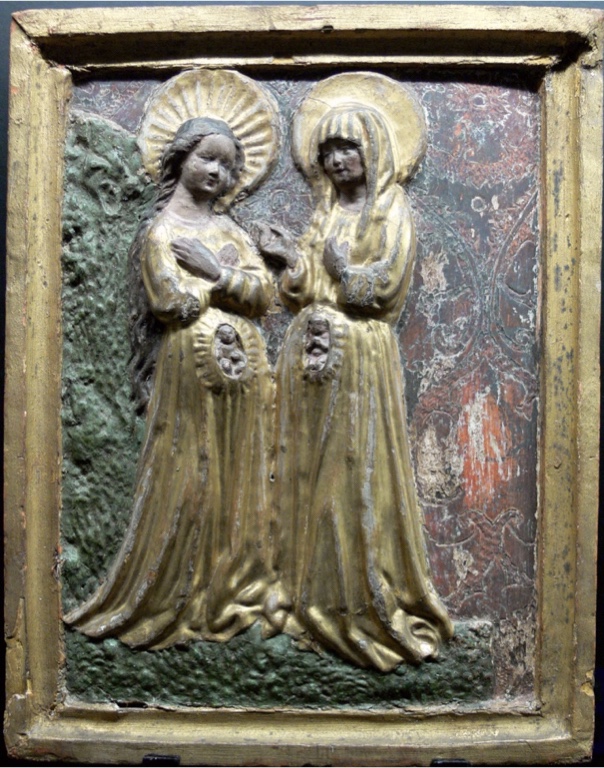 Christmas is about welcoming the most vulnerable.
Christmas is about welcoming the most vulnerable.
That amazingly is not the end of the story. God then invites the most vulnerable of the society into the story – the shepherds – despised and “unreliable”. Would we welcome them?
As I ask that question I cannot help but think of the migrant families today that are stopped at the U.S./Mexican border looking for a place where they can make a livelihood, so vulnerable and despised. Or the refugees on Lesbos in Greece, those turned away by Australia and other countries. They too are considered unreliable, a possible threat to our security. Would we, could we welcome them as God welcomed the vulnerable?
Next come the foreigners, outsiders, of another religion. They too could have and should have been turned away by Jesus Jewish family. Would we have welcomed them?
All of these are the vulnerable image of God – the vulnerable image that shines so brightly not just in the Christ child but in all those who are made in the divine image.
Advent brings the hope of Good News for and to the vulnerable.
These are the vulnerable ones who sing for joy at the good news, who face rejection yet still come because they have caught an awe inspiring glimpse of the One who is bigger than the universe yet small and vulnerable in a young woman’s womb.
This is our vulnerable God who gave voice and song to all creation yet became silent and inarticulate except for the cry of a baby to its mother. This is our vulnerable God who is more powerful than all the rulers of all the created worlds and yet comes as a servant to all, the One who washes feet and gives himself as a sacrifice for this creation.
This is the greatest hope that we can ever look forward to, the hope of a God who comes not in power and might but in weakness and humility. What an incredible God this God of the Universe is.
This morning I was one of the readers for our church’s Carols and Lessons. My reading was this beautiful song by Hildegard of Bingen:
As I continued to reflect on the beautiful service this afternoon, I pulled out my favorite Hildegard of Bingen recording, then went hunting on Youtube for one to share with you too. I have been listening to it ever since and thought you might appreciate it too.
Advent Podcast #2
- Story by Jim and Donna Mathwig
- Music by Aaron Strumpel,In Mansions and Church of the Beloved
- Reflection by Dr. Dwight Friesen
- Story by Jim and Donna Mathwig
- Music by Aaron Strumpel,In Mansions and Church of the Beloved
- Reflection by Dr. Dwight Friesen, Seattle School of Theology and Psychology Seattle WA
- Meditation by Christine Sine, taken from the Advent devotional Waiting for the Light
- Produced by Ryan Marsh, Church of the Beloved
Listen now:
Listen to Donna and Jim share their grief as they lose their home in the recession, enjoy Aaron Strumpel’s music and ponder Dwight Friesen’s profound reflections on Advent and the need to knock on the doors of injustice and anticipate where Christ might be born.
As an Amazon Associate, I receive a small amount for purchases made through appropriate links.
Thank you for supporting Godspace in this way.
When referencing or quoting Godspace Light, please be sure to include the Author (Christine Sine unless otherwise noted), the Title of the article or resource, the Source link where appropriate, and ©Godspacelight.com. Thank you!


